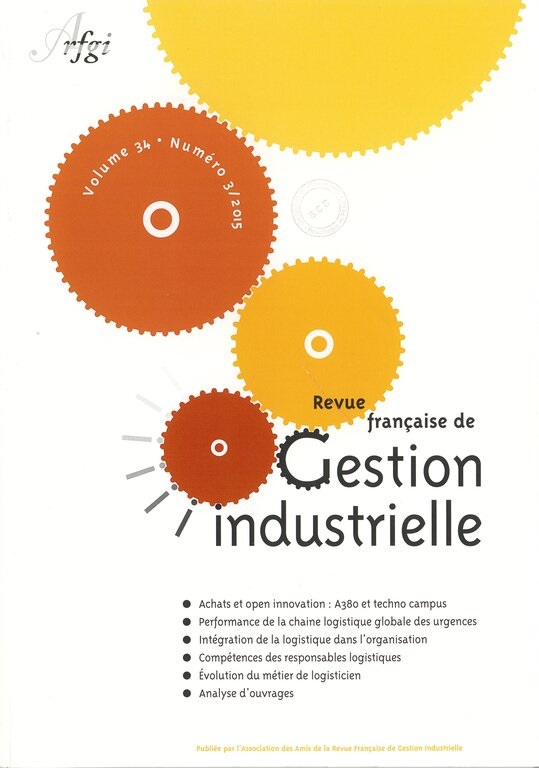Performance de la chaîne logistique globale des urgences vitales
DOI :
https://doi.org/10.53102/2015.34.03.855Mots-clés :
réseaux, performance, environnement hostile, entreprises algériennes, clustersRésumé
Observant que les stratégies de réseaux ne s'inscrivent pas formellement dans la culture stratégique de certaines entreprises, notamment au Maghreb, quelle qu'en soit l'étendue (entre entreprises appartenant à une même région, à un pays ou à une échelle internationale), la thèse soutenue dans cet article considère au contraire que cette forme inter-organisationnelle serait une source première du développement et de performance pour ces entreprises en situation de risques et subissant des coûts de transaction prohibitifs. Cette recherche exploratoire consiste dans un premier temps à mettre l'accent sur les difficultés qui ne permettent pas à des entreprises, ici le cas des firmes algériennes, de se développer en réseaux et de discuter ensuite les raisons qui favorisent davantage les partenariats publics-privés. L'exploitation de l'ensemble de ces informations nous permet de proposer quelques recommandations pour inciter les entreprises, notamment algériennes, à tendre davantage vers la forme en réseau pour se développer dans un avenir au sein d'un environnement hostile porteur de risques prohibitifs. Ces propositions sont transposables à toutes formes d'environnements hostiles au sens économique du terme.
Références
Akkermans, H. and C. Voss (2013). 'The service bullwhip effect" International journal of operations & production management 33(6), pp. 765-788. https://doi.org/10.1108/IJOPM-10-2012-0402
American Heart Association (2014). "Most people have access to stroke care, but few get recommended treatment."
Bhattacharya, R and S. Bandyopadhyay (2011). "A review of the causes of bullwhip effect in a suppl y chain." The International Journal of Advanced Manufacturing Technology 54(9-12), pp. 1245- 1261. https://doi.org/10.1007/s00170-010-2987-6
D' Andreamatteo, A., L. Ianni, et al. (2015). "Lean in Healthcare: a comprehensive review." Health Policy(O). https://doi.org/10.1016/j.healthpol.2015.02.002
Debiais, S., I. Bonnaud, et al. (2007). "Creation of a regional stroke network in Tours hospital (France): consequences for stroke care and thrombolysis." Revue Neurologique 163(8-9), pp. 817-822. https://doi.org/10.1016/s0035-3787(07)91464-2
Disney, S. M. and D. R. Towill (2003). "On the bullwhip and inventory variance produced by an ordering policy." Omega 31(3), pp. 157-167. https://doi.org/10.1016/S0305-0483(03)00028-8
Eissa, A., I. Krass, et al. (2012). "Optimizing the management of acute ischaemic stroke: a review of the utilization of intravenous recombinant tissue plasminogen activator (tPA)." J Clin Pharm Ther 37(6), pp. 620-629. https://doi.org/10.1111/j.1365-2710.2012.01366.x
Fiorelli, M., A. Falcou, et al. (1999). 'The Rome emergency departments network for acute stroke: pilot study on incidence, referral pathways, and eligibility for thrombolytic therapy in Rome urban area." Ital J Neurol Sei 20, pp. S137.
Foerch, C., K. Ghandehari, et al. (2013). "Exploring gender distribution in patients with acute stroke: A multi-national approach." J Res Med Sei 18(1), pp. 10-16.
Forrester, J. W. (1961). Industrial dynarnics, MIT press Cambridge, MA. Fussman, C., A. P. Rafferty, et al. (2010). "Lack of Association Between Stroke Symptom Knowledge and Intent to Call 911 A Population-Based Survey." Stroke 41(7), pp. 1501-1507. https://doi.org/10.1161/strokeaha.110.578195
Grond, M., C. Stenzel, et al. (1998). "Early intravenous thrornbolysis for acute ischemic stroke in a community-based approach." Stroke 29(8), pp. 1544-1549. https://doi.org/10.1161/01.str.29.8.1544
Kelly-Hayes, M. (2010). "Influence of age and health behaviors on stroke risk: lessons from longitudinal studies." J Am Geriatr Soc 58 Suppl 2, pp. S325-328. https://doi.org/10.1111/j.1532-5415.2010.02915.x
Langhorne, P. and M. Dennis (2008). Stroke units: an evidence based approach, Wiley. corn. http://dx.doi.org/10.1002/9780470760215
Lee, S.-Y., R. D. Klassen, et al. (2014). 'The green bullwhip effect Transferring environmental requirements along a supply chain." International journal of production economics 156(0), pp. 39-51. https://doi.org/10.1016/j.ijpe.2014.05.010
Lyerly, M. J., K. C. Albright, et al. (2013). 'The Potential Impact of Maintaining a 3-Hour N Thrombolysis Window: How Many More Patients can we Safely Treat?" J Neurol Disord Stroke 1(2), pp. 1015.
McColl-Kennedy, J. R., S. L. Vargo, et al. (2012). "Health care customer value cocreation practice styles." Journal of Service Research. http://dx.doi.org/10.1177/1094670512442806
McCullen, P. and D. R. Towill (2001). "Practical Ways of Reducing Bullwhip: the case of the Glosuch global supply chain." Contre! December/January, pp. 24-39.
Minvielle, E. (2011). "principal: Projet COMPAQH 2ème phase (2006-2009): rapport final."
Nakhla, M. (2006). "Supply Chain Management et performance de l'entreprise" Value Based Supply Chain Management Mode!"." Logistique & Management 14(1), pp. 65-77. http://dx.doi.org/10.1080/12507970.2006.11516855
Ovbiagele, B. and M. N. Nguyen-Huynh (2011). "Stroke epidemiology: advancing our understanding of disease mechanism and therapy." Neurotherapeutics 8(3), pp. 319-329. https://doi.org/10.1007/s13311-011-0053-1
Porter, M. E. (2010). "What is value in health care?" New England Journal of Medicine 363(26), pp. 2477-2481. https://doi.org/10.1056/nejmp1011024
Rasura, M., M. Baldereschi, et al. (2014). "Effectiveness of public stroke educational interventions: a review." European Journal of Neurology 21(1), pp. 11-20. https://doi.org/10.1111/ene.12266
Samuel, C., K. Gonapa, et al. (2010). "Supply chain dynamics in healthcare services." International journal of health care quality assurance 23(7), pp. 631-642. https://doi.org/10.1108/09526861011071562
Saver, J. L. and S. R. Levine (2010). "Alteplase for ischaemic stroke-much sooner is much better." Lancet 375(9727), pp.1667-1668. http://dx.doi.org/10.1016/S0140-6736(10)60634-4
Schneller, E. S. and L. R. Smeltzer (2006). Strategic management of the health care supply chain, Jossey-Bass San Francisco.
Simonet, D. (2013). "New public management and the reform of French public hospitals." Journal of Public affairs 13(3), pp. 260-271. http://dx.doi.org/10.1002/pa.1465
Sinha, K. K. and E. J. Kohnke (2009). "Health care supply chain design: toward linking the development and delivery of care globally*." Decision Sciences 40(2), pp. 197-212. https://doi.org/10.1111/j.1540-5915.2009.00229.x
Strong, K., C. Mathers, et al. (2007). "Preventing stroke: saving lives around the world." Lancet Neurol 6(2), pp. 182-187. https://doi.org/10.1016/S1474-4422(07)70031-5
Numéro
Comment citer
Rubrique
Licence

Ce travail est disponible sous licence Creative Commons Attribution - Pas d’Utilisation Commerciale 4.0 International.












